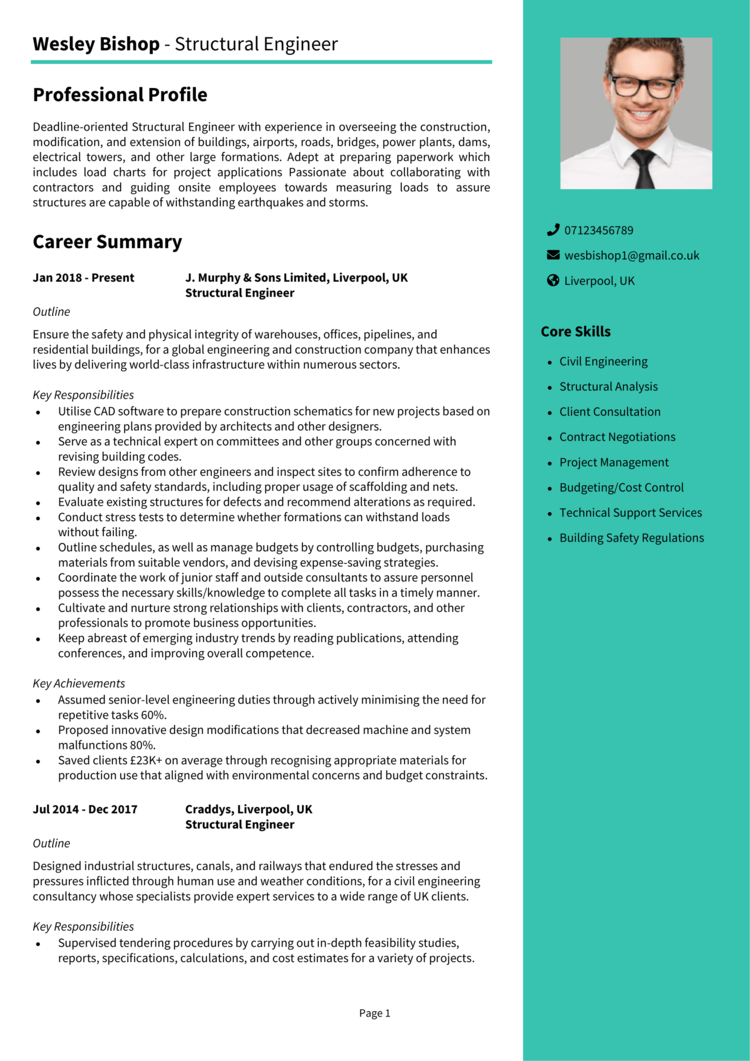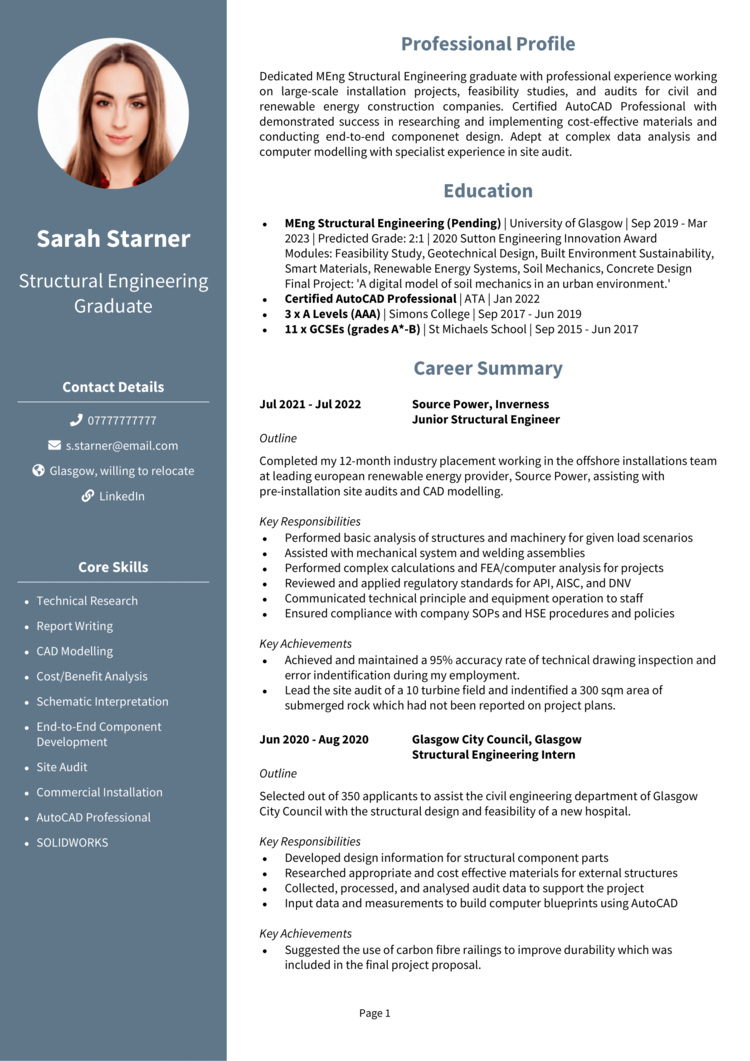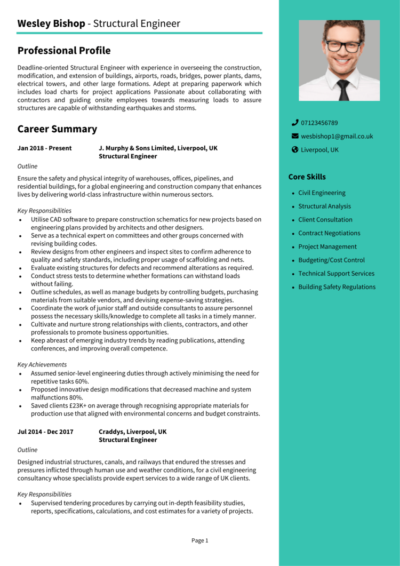A well-designed structure stands the test of time – just like a well-built career. And while your job is to prevent buildings from collapsing, right now, your focus should be on making sure your CV doesn’t crumble under scrutiny.
This guide, along with 2 quality Structural Engineer example CVs, will walk you through creating a CV that showcases your engineering knowledge, project experience, and technical skills, ensuring your application is as solid as the structures you design.
Structural Engineer CV

Graduate Structural Engineer CV

How to write your Structural Engineer CV
Learn how to create your own interview-winning Structural Engineer CV with this simple step-by-step guide.
A structural engineer’s CV should be built on strong foundations – if it’s poorly structured or missing key information, hiring managers won’t stick around to see if the details are any better.
This guide covers everything from structuring and formatting your CV to presenting your qualifications, skills, and engineering projects effectively. By the end, you’ll have a CV that stands up to scrutiny and gets you noticed in a competitive industry.
Structural Engineer CV structure


Just like a well-planned construction project, your CV’s layout needs to be carefully structured – no unnecessary reinforcements, no weak points, and definitely no missing support beams (or, in this case, key details).
Here’s how to organise your CV structure:
- Name and contact details – Keep your personal details and an optional photo at the top so hiring managers can easily reach you.
- Profile – Open with a concise summary that highlights your structural engineering expertise, problem-solving skills, and industry experience.
- Core skills – Provide a snapshot of your most relevant technical skills, such as load calculations, materials analysis, and CAD proficiency.
- Work experience – Detail your previous engineering roles in reverse chronological order, showcasing your most significant projects when you’re writing a CV.
- Education – List your academic qualifications, starting with the most recent.
- Additional info – Include professional certifications, hobbies, industry memberships, or notable awards.
The best way to format your Structural Engineer CV


A well-presented CV should be as clear and structured as an engineering blueprint. If it’s cluttered or disorganised, hiring managers may assume the same about your work – so don’t let avoidable mistakes cause you to lose out.
Follow these tips when you’re putting together your format:
- Bullet points – Use them to highlight responsibilities and achievements clearly.
- Divide sections – Structure your CV logically so key details are easy to find.
- Use a clear and readable font – Keep your choice of font professional and legible.
- No more than 2 pages – Stick to a concise length while ensuring you highlight your most relevant experience and qualifications.
Structural Engineer CV profile


Your CV profile is the foundation of your application. This short introduction should summarise your expertise and highlight your most valuable skills as a structural engineer: enough to convince any recruiters that you’re the right fit for the job.
Structural Engineer CV profile examples
Profile 1
Detail-oriented Structural Engineer with four years of experience designing and analysing structural systems for commercial and residential projects. Skilled in using AutoCAD, Revit, and structural analysis software such as SAP2000 and STAAD.Pro. Experienced in collaborating with architects and contractors to ensure safe, cost-effective, and sustainable designs. Passionate about delivering innovative engineering solutions while maintaining compliance with industry standards.
Profile 2
Proficient Structural Engineer with three years of experience in civil infrastructure projects, specialising in bridge design and foundation analysis. Adept at performing load calculations, preparing technical reports, and using finite element analysis (FEA) software. Skilled in managing project timelines and working with multidisciplinary teams to ensure structural integrity and efficiency.
Profile 3
Experienced Structural Engineer with over six years of expertise in high-rise building design, seismic assessment, and structural retrofitting. Skilled in leading design projects from concept to construction, ensuring compliance with industry codes such as Eurocodes, AISC, and BS standards. Proficient in structural modelling software such as ETABS and Tekla Structures. Dedicated to delivering sustainable and resilient structures.
What to include in your Structural Engineer CV profile
To make an impact, you’ll need to include:
- Your industry experience – Have you worked in commercial, residential, industrial, or infrastructure projects?
- Key technical skills – Whether it’s seismic analysis, steel and concrete design, or finite element modelling, showcase your expertise.
- Project experience – Mention major projects you’ve contributed to, especially if they were high-profile or technically complex.
- Regulatory knowledge – Employers look for engineers who understand building codes, safety regulations, and compliance requirements.
- Software proficiency – If you’re experienced with AutoCAD, Revit, SAP2000, or similar engineering tools, highlight it here.
What to include in the core skills section of your CV


A core CV skills section provides hiring managers with a quick overview of your expertise. Structural engineering roles vary across industries, so tailor this section to match the job description and highlight the areas where you excel.
For example, if you specialise in bridges, focus on load-bearing analysis and materials engineering. If you work in high-rise construction, emphasise lateral stability design and wind load calculations. The more aligned your skills are with the role, the stronger your CV will be.
Key skills that make a Structural Engineer CV stand out
- Structural Analysis – Evaluating loads, forces, and stresses to ensure structural integrity and stability.
- Finite Element Modelling (FEM) – Using software like SAP2000, ETABS, or ANSYS to simulate structural behaviour.
- Reinforced Concrete and Steel Design – Designing safe and efficient structures using materials like concrete, steel, timber, and composites.
- AutoCAD and BIM Software – Creating detailed drawings and models with tools like AutoCAD, Revit, or Tekla Structures.
- Seismic and Wind Load Analysis – Assessing structures for earthquake and wind resistance to comply with safety standards.
- Foundation Engineering – Designing shallow and deep foundations to support various types of structures.
- Construction Material Knowledge – Understanding the properties and applications of construction materials for optimal design solutions.
- Structural Safety Codes and Compliance – Ensuring designs adhere to industry standards such as Eurocodes, ACI, or BS standards.
- Site Inspections and Supervision – Overseeing construction progress to ensure alignment with design specifications.
- Project Management and Coordination – Collaborating with architects, contractors, and stakeholders to deliver projects efficiently.
How to showcase your work experience on your CV


Your work experience should demonstrate more than just job titles – it should highlight the impact you’ve made. Structural engineers are problem solvers, and your CV should show how you’ve contributed to safe, efficient, and innovative design solutions.
List your roles in reverse chronological order, focusing on major projects, engineering challenges, and technical contributions. If you’ve worked on high-profile developments, be sure to highlight them.
How to structure jobs

- Outline – Introduce the company, the sector, and your role in the engineering team.
- Responsibilities – List your key tasks, such as designing load-bearing structures, conducting site inspections, or performing structural integrity assessments. Use action words like “designed”, “calculated”, and “evaluated”.
- Achievements – Highlight measurable outcomes, such as reducing material costs, improving structural efficiency, or delivering a project ahead of schedule. Where possible, use figures and metrics to demonstrate your impact.
Example jobs for Structural Engineer
Structural Engineer | Urban Build Solutions
Outline
Designed and analysed structural components for commercial and residential buildings within a structural engineering consultancy, ensuring safety, compliance with industry regulations, and optimal material efficiency.
Responsibilities
- Performed structural calculations and load analysis to assess material strength and stability.
- Developed detailed technical drawings using AutoCAD and Revit.
- Collaborated with architects, contractors, and project managers to optimise structural designs.
- Conducted site visits to inspect construction progress and resolve design challenges.
- Prepared technical reports and ensured designs met local and international building codes.
Achievements
- Optimised structural designs, reducing material costs by 15 percent without compromising safety.
- Successfully led the design of a 10-storey mixed-use building, completed ahead of schedule.
- Recognised for improving structural efficiency through innovative design solutions.
Structural Engineer | Infrastructural Ltd
Outline
Provided structural design and analysis for bridges, roads, and civil infrastructure projects within a civil engineering firm, ensuring stability, durability, and adherence to regulatory standards.
Responsibilities
- Conducted structural assessments and finite element analysis (FEA) for bridge design projects.
- Developed foundation and reinforcement plans based on soil investigation reports.
- Worked closely with geotechnical engineers to ensure proper load-bearing capacity of structures.
- Reviewed contractor drawings and specifications to verify compliance with design requirements.
- Assisted in preparing budget estimates and material specifications for civil projects.
Achievements
- Designed a cost-effective foundation system that reduced construction expenses by 10 percent.
- Improved bridge stability by implementing advanced reinforcement techniques.
- Received commendation for technical expertise and problem-solving skills in complex designs.
Senior Structural Engineer | Megascale Engineering
Outline
Led the structural design and analysis of large-scale commercial and industrial projects, ensuring structural integrity and compliance with international standards.
Responsibilities
- Managed structural engineering teams, overseeing design development and calculations.
- Performed seismic analysis and retrofitting assessments for high-risk structures.
- Reviewed and approved structural drawings, ensuring quality and accuracy.
- Provided technical guidance to junior engineers and conducted training sessions.
- Coordinated with stakeholders to resolve engineering challenges and optimise construction plans.
Achievements
- Successfully designed and implemented a seismic retrofitting strategy that improved building resilience.
- Reduced project costs by 20 percent through value engineering and material optimisation.
- Recognised by senior management for delivering complex projects within tight deadlines.
What should your CVs education section include?


For structural engineers, academic qualifications are a major factor in hiring decisions. Your education section should list your degrees and any additional certifications that enhance your expertise.
If you’re a recent graduate, highlight coursework or projects that demonstrate your engineering skills. If you’re experienced, keep this section brief and focus on your professional accomplishments.
List qualifications in reverse chronological order, starting with the most recent.
Best qualifications for Structural Engineers
- BEng/MEng in Civil or Structural Engineering – The fundamental degree required for structural engineering roles.
- Chartered Engineer (CEng) Status – A highly respected qualification that demonstrates professional competence.
- Institution of Structural Engineers (IStructE) Certification – Recognised globally as a benchmark for engineering excellence.
- AutoCAD/Revit Structural Design Certification – Useful for engineers working extensively with design and drafting software.
- Project Management Qualification (PRINCE2 or PMP) – Valuable for engineers involved in managing large-scale projects.





